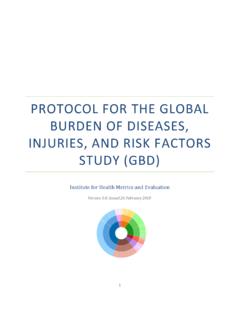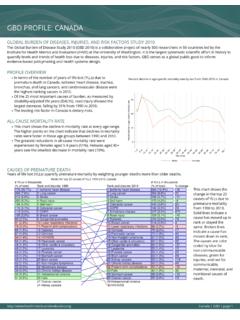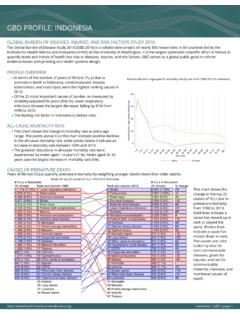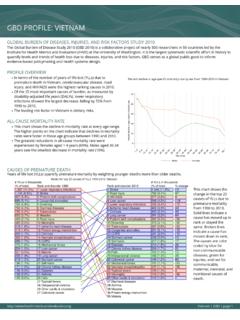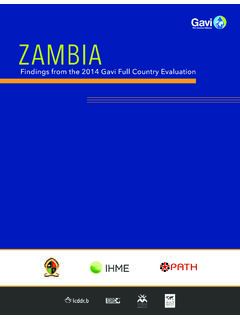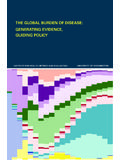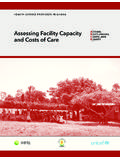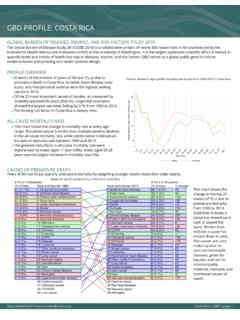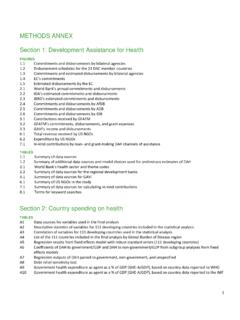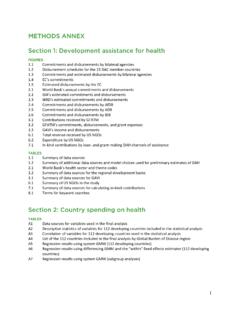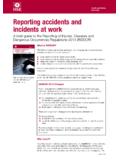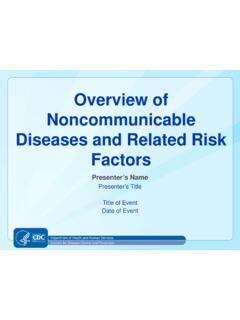Transcription of GBD 2013: Global Burden of Disease s, Injuries, and Risk ...
1 GBD 2013 : Global Burden of diseases , injuries , and risk factors Protocol July 24, 2013 . 1. 2. This protocol outlines the key roles, responsibilities, decisionmaking processes, and deliverables included in the Global Burden of diseases , injuries , and risk factors Study 2013 (GBD 2013 ) and is intended for all individuals directly engaged in the GBD 2013 . The protocol is valid throughout the duration of the GBD 2013 ; the protocol will be updated for subsequent iterations of the GBD taking into account lessons learned. The most current version will be posted at the following URL: The date of the most recent modification will be noted on the protocol. As an institute of the University of Washington (UW), IHME is subject to the policies and procedures of the UW. Accordingly, the GBD 2013 shall be conducted in full compliance with UW policies and procedures, as well as applicable federal, state, and local laws.
2 Table of Contents Section 1. Introduction .. 4. Purpose and Goals of GBD 2013 .. 4. Organization of the GBD 5. Section 2. Key Principles and 5. Comprehensive Comparisons .. 5. Uncertainty .. 6. Internal Consistency .. 6. Iterative Approach to Estimation .. 6. Data Synthesis Principles .. 6. Construction of 7. Section 3. Key products and timelines .. 7. Products .. 7. General 8. Section 4. Roles, responsibilities, and GBD Scientific Council ..17. Core Analytic GBD Experts ..19. 1. GBD Experts on all-cause mortality ..19. 2. GBD Experts on a particular Disease , injury, risk factor, or 3. GBD Experts on a particular country ..21. GBD Management Team ..22. 3. Independent Advisory Committee ..22. Adjudication ..22. Section 5. Estimation Flow ..24. 1. Covariates database ..24. 2-4. Age-specific mortality 5-7. Cause of death database ..25. 8. Estimating causes of death.
3 25. 9. Ensuring consistency between cause-specific estimates and all-cause mortality 10. Disease sequelae epidemiology data ..26. 11. Estimating Disease sequelae prevalence, incidence, and duration ..26. 12. Impairment 13. Nature and external cause of injury analysis ..26. 14. Disability weights for health 15. Severity 16. Comorbidity simulation ..27. 17. Healthy life expectancy ..27. 18a-c. Computation of YLLs, YLDs, and DALYs from diseases and injuries with uncertainty ..27. Risk factor exposure database ..28. 19. Estimating the prevalence of exposure ..28. 20. Theoretical minimum risk 21. Estimating relative risks for risk-outcome pairs ..28. 22a-c. Computation of attributable Burden for each risk factor with uncertainty ..28. Section 6. GBD 2013 Country List, Age and Sex Groups, and Cause Lists ..29. Countries ..29. Age groups ..30. Sex ..31. Cause lists.
4 31. Diseases and injuries cause list ..31. Risk factor Ranking lists ..32. Section 7. Data ..32. Data Access 4. Section 8. Publications and Capstone Papers Presenting Overall Estimates ..35. Disease -specific, Risk Factor-Specific, Disability Weight, and General Methodology Papers ..37. Country-Specific, Region-Specific, and Global Age-Specific Papers ..38. Policy Reports and Briefs ..38. Posters ..38. Presentations ..39. Section 1. Introduction Purpose and Goals of GBD 2013 . The Global Burden of diseases , injuries , and risk factors (GBD) is an approach to Global descriptive epidemiology. It is a systematic, scientific effort to quantify the comparative magnitude of health loss due to diseases, injuries , and risk factors by age, sex, and geographies for specific points in time. The GBD is led by the Institute for Health Metrics and Evaluation (IHME) at the University of Washington.
5 Comparison is at the heart of the GBD approach. For decision-makers, health-sector leaders, researchers, and informed citizens, the GBD approach provides an opportunity to see the big picture, to compare diseases, injuries , and risk factors , and to understand in a given place, time, and age-sex group, what are the most important contributors to health loss. To ensure a health system is adequately aligned to a population's true health challenges, policymakers must be able to compare the effects of different diseases that kill people prematurely and cause ill health and disability. Going forward, the GBD will produce ongoing estimates of all-cause mortality, deaths by cause, years of life lost (YLLs), years lived with disability (YLDs), and disability adjusted life years (DALYs) for a comprehensive cause list-- including, at minimum, the 291 causes of diseases and injuries and the 67.
6 Risk factors estimated in the GBD Study 20101 . The core costs of the ongoing estimation are supported in part through funding from the Bill & Melinda Gates Foundation; the critical milestones for that support include annual updates to the GBD estimates. This protocol is specific to the next GBD update, the GBD 2013 . When the new estimates for GBD 2013 are produced, the entire time series back to 1990 will be re-estimated using all available data to ensure the most complete and highly comparable set of estimates possible; previous results will be archived every time new results are released. The GBD 2013 will provide cutting-edge and timely results through creative and explanatory visualizations, updated with the most current data. The GBD 2013 will use and expand upon the infrastructure of methodology, datasets, and tools that were presented in the GBD Study 20101 8 in order to produce estimates that will provide policymakers, researchers, donors, and other decision makers with the most timely and up-to-date picture of population health to inform critical decisions.
7 Any proposed updates to 5. methodology used in GBD 2010 or cause lists will be approved by a GBD Scientific Council, as detailed below. Organization of the GBD 2013 . The GBD 2013 will include a Core Analytic Team, a Scientific Council, a management team, and a robust network of GBD Experts working together to produce the most accurate, up-to-date, and comparable estimates of Burden world-wide. More information about each of these groups is listed below in the Roles and Responsibilities Section below. IHME, the institutional home of the GBD 2013 , envisions engaging individual collaborators as GBD. Experts in a range of ways, including: 1. Providing expertise, access to, and feedback on the data used for all-cause mortality estimation. 2. Providing expertise and feedback on the results generated for the all-cause mortality envelope. 3. Providing expertise, access to, and feedback on the data used for the analyses of specific diseases, injuries , risk factors , or impairments.
8 4. Providing expertise and feedback on the validity and interpretation of results generated for specific diseases, injuries , risk factors , or impairments. 5. Providing expertise, access to, and feedback on the data used for country-specific results. 6. Providing expertise and feedback on the validity and interpretation results generated for a specific country. 7. Where possible, engaging even more closely to generate subnational estimates for specific countries that are consistent with the overall Global and national estimates produced annually. 8. Translating the results of the GBD 2013 , in order to maximize policy uptake and action. Section 2. Key Principles and Assumptions The GBD 2013 will embed a set of key principles and assumptions to ensure the highest quality and most useful set of results possible. The data used and the analytic strategies applied to generate the results will be consistent with these principles and assumptions.
9 Any changes to the principles and assumptions will be presented to and discussed by the GBD Scientific Council; accepted changes will be added as a modification to this protocol. Comprehensive Comparisons 1. The GBD 2013 cause list is a set of mutually exclusive and collectively exhaustive hierarchical categories. 2. Results from the GBD 2013 are intended to facilitate comparison. 3. All quantities of interest will be estimated in all time periods. An uncertain estimate, even when data are sparse or not available, is preferable to no estimate because no estimate is often taken to mean no Burden from that condition. 6. Uncertainty 1. Because the GBD 2013 produces estimates for a mutually exclusive and collectively exhaustive set of Disease and injury causes, it is important to convey to users the strength of the evidence for each quantity through the reporting of uncertainty intervals.
10 2. The GBD 2013 estimates uncertainty distributions for each quantity and reports and visualizes various metrics of uncertainty, such as 95% uncertainty intervals. Internal Consistency 1. The sum of cause-specific mortality must equal all-cause mortality following ICD underlying cause rules. 2. The sum of cause-specific estimates of impairments, such as blindness, must equal estimates of all-cause impairments. 3. Where we believe incidence, prevalence, remission, duration, and excess mortality are not changing over time we require rates to be internally consistent Iterative Approach to Estimation 1. New data and methodological innovation will lead to revision of estimates. 2. Burden of Disease estimation is an iterative process. Revisions will result in a re-estimation of the entire time series so that results are always available over time using consistent data and methods.
